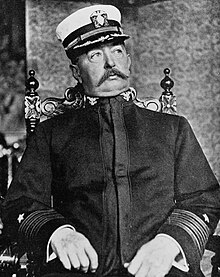| William Henry Hudson Southerland | |
|---|---|
 Southerland, c. 1907 Southerland, c. 1907 | |
| Born | (1852-07-10)July 10, 1852 New York City, US |
| Died | January 30, 1933(1933-01-30) (aged 80) Washington, D.C., US |
| Allegiance | United States of America |
| Service | |
| Years of service | 1865; 1867–1914 |
| Rank | |
| Commands | Eagle Yankee Cleveland (C-19) New Jersey (BB-16) Pacific Fleet |
| Battles / wars | American Civil War Spanish–American War Occupation of Nicaragua |
| Relations | J. Butler Wright (son-in-law) |
William Henry Hudson Southerland (July 10, 1852 – January 30, 1933) was a rear admiral in the United States Navy. He commanded several ships in Cuban waters during the Spanish–American War, and later served as Commander in Chief of the Pacific Fleet.
Biography
Southerland was born on July 10, 1852, in New York City, to William and Phoebe E. Southerland. Southerland first joined the Union Navy as a volunteer towards the end of the Civil War, despite being only twelve years old, serving for only a brief time. He re-enlisted in early 1867 as a naval apprentice, finally entered the United States Naval Academy in June 1868, shortly before his sixteenth birthday.
After graduating second in his class from the Academy on June 1, 1872, he served aboard the sloop Tuscarora. After a year at sea, he was commissioned as an ensign. From 1875 to 1876, he returned to the Academy as a staff member.
Over the next 34 years, Southerland served in varied positions at sea and ashore, including duty with the Hydrographic Office, the Bureau of Equipment, and the Board of Inspection and Survey. During the Spanish–American War, he commanded the gunboat Eagle in the blockade of Cuban ports; and, in 1905, he returned to the Caribbean to command Yankee and to act as Senior Officer, Naval Forces in Santo Domingo. In between, he supervised the fitting out of the protected cruiser Cleveland (C-19) before briefly serving as her first commander in November 1903. Promoted to captain in 1906, he commanded the battleship New Jersey (BB-16) of the Great White Fleet in 1907–09. He graduated from the Naval War College in 1909.

Appointed rear admiral on May 4, 1910, he served as President of the Board of Inspection and Survey for Shore Stations until becoming Commander, 2nd Division, Pacific Fleet in March 1911, and commanded naval forces in the Nicaragua Expedition. In 1912, he became Commander in Chief, Pacific Fleet; and, in March 1913, he left the fleet to take up duties on the General Board.
On his retirement on July 10, 1914, at age 62, Southerland was the last Civil War naval veteran still in active service, and one of very few to rise from enlisted man to admiral in the course of his career.
Admiral Southerland died in Washington, D.C., on January 30, 1933. He was interred at Arlington National Cemetery on February 2, 1933, aged 80.
The destroyer USS Southerland (DD-743) (1944–1981) was named in his honor.
Family
On August 1, 1877, Southerland married Mary Rodman (1859–1935). She was the first cousin of Navy officer Hugh Rodman. The couple had two daughters, one of whom married diplomat J. Butler Wright. After his retirement, Southerland and his wife lived in Washington, D.C.
References
- ^ Marquis, Albert Nelson (1923). "Southerland, William Henry Hudson". Who's Who in America. Vol. 12. Chicago, Illinois: A. N. Marquis & Company. p. 2882. Archived from the original on 19 August 2023. Retrieved 19 August 2023.
- Register of Alumni: Graduates and Former Naval Cadets and Midshipmen. The United States Naval Academy Alumni Association, Inc. 1 July 1956. p. 140. Archived from the original on 18 August 2023. Retrieved 19 August 2023.
- ^ "LAST OF CIVIL WAR NAVAL HEROES TO GO : Rear Admiral Southerland Retires Automatically Friday Under the Age Limit" (PDF). The New York Times. 6 July 1914. Archived (PDF) from the original on 15 May 2022. Retrieved 8 November 2010.
- ^ "Southerland". Dictionary of American Naval Fighting Ships. Navy Department, Naval History & Heritage Command. Retrieved 8 November 2010.
- Hamersly, Lewis Randolph (1898). "W. H. H. Southerland". The Records of Living Officers of the U.S. Navy and Marine Corps. New York, New York: L. R. Hamersly & Company. p. 173. Retrieved 19 August 2023.
- "USS Cleveland (Cruiser No. 19/PG 33/CL 21)". NavSource Naval History. Archived from the original on 11 July 2023. Retrieved 18 August 2023.
- "Great White Fleet Battleships". hazegray.org. Archived from the original on 5 December 2010. Retrieved 8 November 2010.
- Register of Officers 1884–1977. The United States Naval War College. 1977. p. 14. Retrieved 18 August 2023.
- "Southerland, William H". ANCExplorer. U.S. Army. Archived from the original on 23 July 2023. Retrieved 18 August 2023.
- "Southerland Dies; Was Rear Admiral: Commander-in-Chief of the Pacific Fleet for 2 Years Before World War" (PDF). The New York Times. 31 January 1933. p. 17. Retrieved 19 August 2023.
- "Southerland, Mary R". ANCExplorer. U.S. Army. Archived from the original on 23 July 2023. Retrieved 19 August 2023.
 This article incorporates text from the public domain Dictionary of American Naval Fighting Ships. The entry can be found here.
This article incorporates text from the public domain Dictionary of American Naval Fighting Ships. The entry can be found here.
| Military offices | ||
|---|---|---|
| Preceded byChauncey Thomas, Jr. | Commander-in-Chief of the U.S. Pacific Fleet 1912–March 1913 |
Succeeded byWalter C. Cowles |
- 1852 births
- 1933 deaths
- 20th-century American naval officers
- Military personnel from New York City
- People of New York (state) in the American Civil War
- Union Navy sailors
- United States Naval Academy alumni
- United States Naval Academy faculty
- United States Navy personnel of the Spanish–American War
- Naval War College alumni
- United States Navy admirals
- Military personnel from Washington, D.C.
- Burials at Arlington National Cemetery